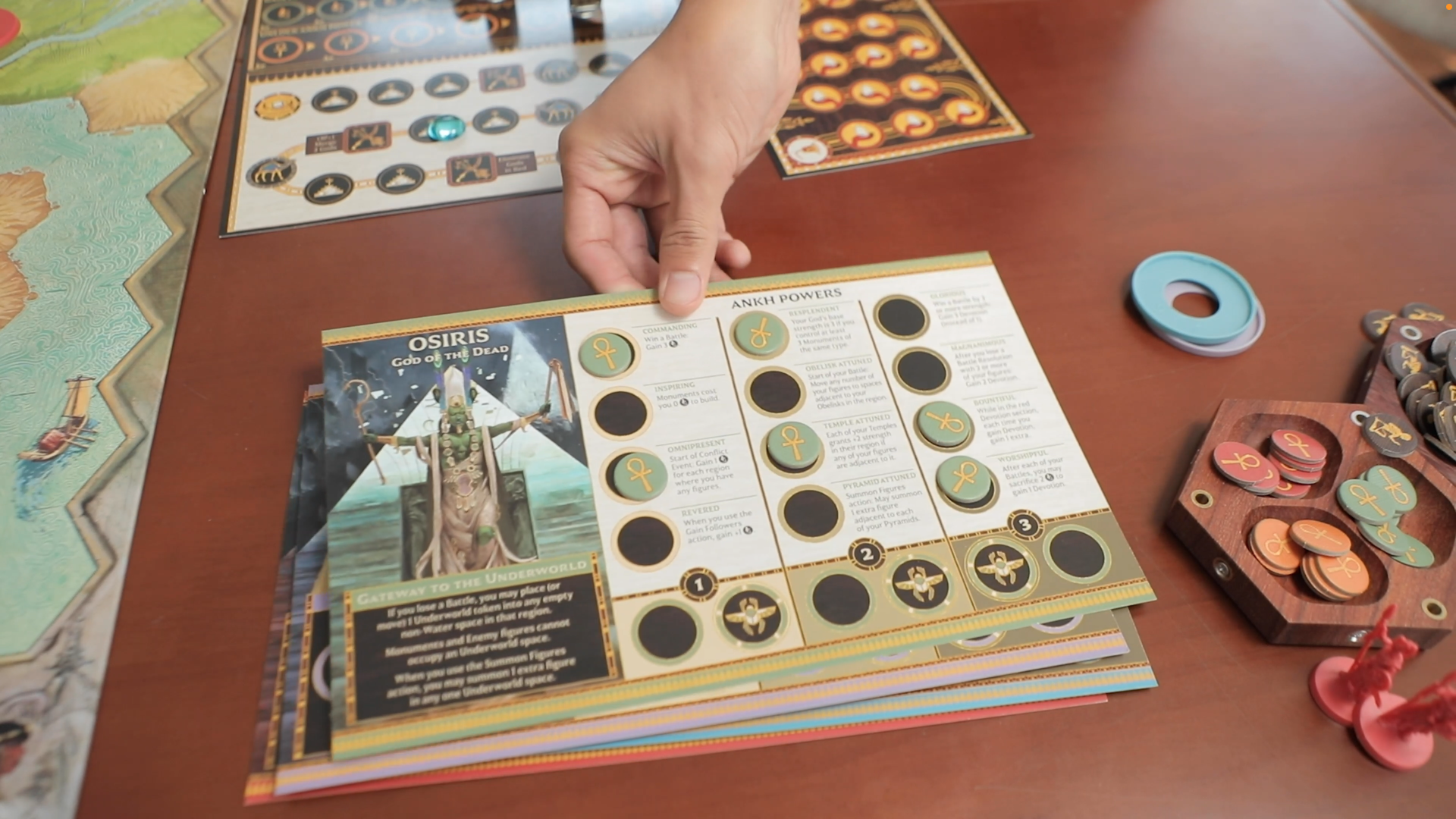Ankh
: Gods of Egypt Review
Many bizarre unions.
The final installment of the Eric M. Lang trilogy of area control for 2-5 people, featuring a… merge!? Asymmetric gods, luckless card driven combat, in 1-2 hours.
Video published September 21st, 2021

Card based combat system with an included bidding mechanic.

Each players' actions will move these tracks up.

5 different Egyptian gods to play.
Overview & How to Play
Blood Rage. Rising Sun. Now… Ankh. This it the final installment of the Eric M. Lang trilogy of area control for 2-5 people.
You control a god, along with a bunch of warriors to reach the most devotion, all while 2 stragglers will literally MERGE with another, 2/3rds through the game!
In your god’s quest to get as much holy devotion as possible, there’s 0 luck.
Actions include players gaining followers, moving units on the board, or upgrading their technology. Yet everytime a player takes an action, it moves a shared marker to the right, and so eventually those markers will trigger conflicts after someone takes an action. Then, each region will have players fight for control over it, via playing combat cards from their hand.
Pros
Ankh really makes a statement on the table (base game components shown), with minis everywhere, because, ya know, Eric M. Lang kickstarter stuff.
The mechanics are just built different with Ankh’s action system though, keeping each player tied to each other in a very streamlined process. You are always in the know-how what your opponents can do.
But what really makes Ankh, Ankh, is the conflict system. When you’re fighting each other, the hand of combat cards, isn’t really a hand of combat cards. They can feel more of like a set of another actions for a different phase. There’s also cool tricks you can pull, like a Plague of Locusts to cause players to bid their followers (yes sacrificing literal humans).
There’s all sorts of cool ways to squeeze Ankh’s combat for advantage, like getting points through voluntarily losing troops, or fighting on desert for even MORE points. Or just build a Monument during combat.
Adjacencies are really fascinating in Ankh, where you don’t have to be adjacent to fight, rather in the same area, making players really care about the terrain, or blocking off and creating new regions with the Camel system.
With the multiple asymmetrical powers, cool techs getting unlocked (e.g. teleport your god around the map multiple times), thematic Guardians to get with their own abilities, and with a tight combat system, Ankh has so much going for it.
Cons & Nitpicks
Big honcho topic: the merging. This is especially gonna be terrible in your first couple of games, as you don’t have prior knowledge of power dynamics and scoring.
Overall though, merging is a non-decision MANDATORY thing, with concerns for balance because of Ankh’s variances of board states: there’s so many shapes and sizes of devotion (VP) placement, board states, and god abilities. Maybe the combined god will be too strong. Maybe it’ll be too unfair feeling to the second-to-last place god. Yes, the merging should start to get better once people get more experienced with the game.. but there’s still no guarantees on balance for something that happens after 1-2+ hours of concentration.
There is a non-merge variant in the scenario booklet… which isn’t ironed out. So there’s no current good variant to merging.
This, paired onto Ankh having HUGE concerns with player order unfairness, where some players just wouldn’t get as many monuments, or technologies, really concerned us. Other things just didn’t feel complete, like Ankh technology strength, some Guardians, or how followers can only be spent for Swarm of Locusts.
Funnily enough, Ankh’s saving grace is its 2p, where there’s no merge and the action selection system works more cleanly. But watch out for some god matchups not pairing well.













